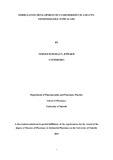| dc.description.abstract | Introduction
Topical gels that satisfy the Target product profile are approved as formulations that are stable and proved to have effective in-vitro release and therapeutic activity. The skin been the biggest defense organ creates a vast opportunity as a delivery point for topical application drugs. In acne treatment and management many drug regimens are available but not as a single combined unit formulation in both topical and oral formulations. Topical Erythromycin gel and Metronidazole gel are available as separate product in the market, at the same time this two drugs are prescribed for the treatment and management of acne, in most cases compounding takes place at most pharmacies by mixing the two product, this is an expensive affair to the patient and this might also affect the pharmacokinetics of the product. This lead to the innovation of a combined dosage form of Erythromycin /Metronidazole as a topical gel using carbomer polymers. Erythromycin as a Macrolide antibiotic is an inhibitors of protein synthesis. Metronidazole is a synthetic nitro-imidazole, the mechanism of action include anti-inflammatory properties and antibacterial as documented in most literature studies. Acne been a long term disease, patient compliant to medication is key, therapeutically effective and cosmetically elegant dug as a combination in a topical gel dosage form will enhance better treatment and management of the disease.
Methodology
The topical gel formulation of 2% Erythromycin and 0.75% Metronidazole combination was done by factorial experimental design. The product development was done first, by having the known Target product profile qualities to be achieved. Secondly the pre-formulation studies were done for the actives pharmaceutical ingredient properties on solubility in different diluents and also by combining the different diluents in different ratios to achieve maximum solubility at room temperature and pressure. Thirdly the compatibility studies, both physical compatibility and chemical compatibility for the actives and excipients were done by Physical observation and FT-IR spectroscopy respectively. The polymer used in the formulation was carbopol 940 in 0.5% and 1.5% concentration respectively. Hydroxyl Propyl methyl cellulose (HPMC) as a thickening agent was also used in 1%, 1.5% and 2% concentration respectively. The topical gel permeation enhancer employed was by using a methanol 60%/ water 40% system. The topical gel formulation was analyzed for different parameter such as pH as an in-process parameter and end product parameter, viscosity, micro-bioassay and drug content. Solubility been a major key aspect in the formulation various vehicles were tested and the best result in a system consisting of a ratio of 60% methanol: 40% water. Post formulation studies for each formulated topical gels were organoleptic properties as per set standard in the target product profile including clarity, homogenecity, phase separation, grittiness and pH. Analysis was also done for viscosity, micro-bioassay and drug content. HPLC method was initially tried for simultaneous analysis of both API’s to determine the label claim but results were inconclusive. Drug content analysis was done for Metronidazole using UV/VIS spectroscopy method.
Results
In the pre-formulation studies complete solubility for both the API, s was achieved in 60% methanol: 40% water ratio. There was no incompatibility observed from the FT-IR spectra in the API, s and excipients used from the characterized absorption encountered in the parent hydrocarbon species and the associated back-born groups. In the post formulation studies organoleptic characteristic of the formulated gels showed descriptive result in all the tests done to be within the limits set for a topical gels, the only varying descriptive observation was in the clarity test, same turbidity was observed in formulation G1, G3, G5 and G7. pH was within the limit set of between 4 - 6.5 for all the formulations .The viscosity was performed at the 2nd month and formulation G1, G3, G5 and G7 were within limits (10%-90%) as per the viscometer used NJS-5S rotating viscometer. Formulation G2, G4, G6 and G8 were not above 100% which was also considered within limit (1000mpa.s-10000mpa.s). The micro-bioassay analysis was done and the formulation activity index was calculated, the descriptive results showed formulations G1 to G8 zones of inhibition close to that of the reference drug .Formulations G1, G3, G5 and G7 indicated better descriptive zone of inhibition as that of reference drug from the microbial activity index results for both high and low concentration. Percentage label claim for Metronidazole was within limit as per BP, for formulation G1, G5, G6, G7 and G8 between 90 -110% w/w | en_US |
| dc.description.department | a
Department of Psychiatry, University of Nairobi, ; bDepartment of Mental Health, School of Medicine,
Moi University, Eldoret, Kenya | |

